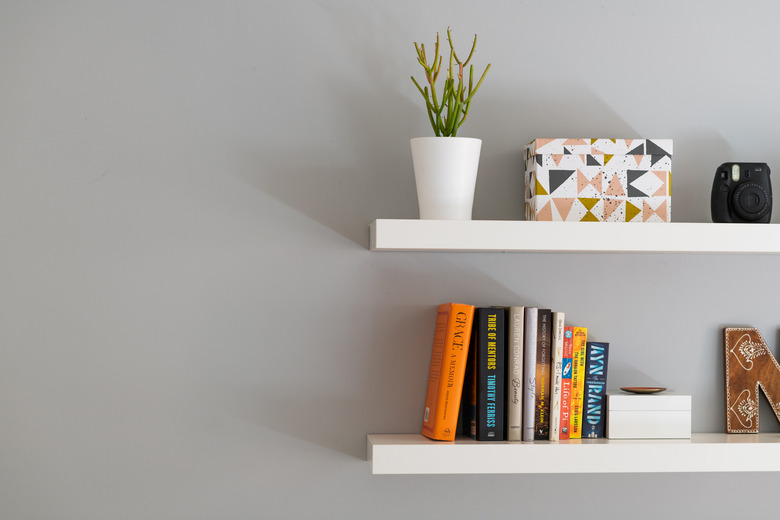How Far Apart Should Floating Shelves Be Hung?
We may receive a commission on purchases made from links.
Installing floating shelves is a space-saving way to display your books, art, and even kitchen supplies. Using floating shelves for dishes and glassware helps you maximize cabinet space in a small kitchen, and if you're stumped on how to fill a blank wall with style, hanging floating shelves is a good start. Once they're up, add a few framed prints and small potted plants for an instant wall makeover — but first, make an installation plan. Don't drill any holes into your walls until you know exactly how far apart you need your shelves to be.
Is There a 'Right' Distance for Floating Shelves?
Is There a 'Right' Distance for Floating Shelves?
Art galleries often use 57 as a magic number. Hanging a piece of art so its center point is 57 inches above the floor puts it at eye level for most adults. Using the 57-inch rule at home takes the guesswork out of mounting art in a living room or bedroom.
There's no such rule of thumb for hanging floating shelves. The good news is that there's no wrong height for your shelves, but the bad news is that there's no right height either. The wall dimensions, the number and length of shelves you need, and the height of the items you plan to display will determine how you lay out your shelves. You might also want to center shelves over a piece of furniture.
For example, the distance between floating shelves in bathrooms is probably going to be different from the distance between floating shelves in other rooms of your home just because the bathroom has so much less space. If you want to create a lot of storage for holding small baskets, you might hang three or four shelves with a vertical distance of just 10 or 12 inches between them. But if you're hanging shelves to hold stacks of fluffy towels or tall hardcover books, you might want to leave more like 16 or 20 inches of vertical space between them, which might mean you only have enough room for two shelves.
Planning Floating Shelves
Planning Floating Shelves
While you have a lot of leeway for how much space you leave between floating shelves, the most important placement concern is that you securely anchor your brackets into wall studs. It's risky to hang shelves on plaster walls unless you screw the floating shelf brackets into the vertical support beams running behind the walls. Drywall or plaster may not be strong enough to hold up your shelves, especially once you add weight to them.
Locate the studs in the wall where you plan to hang shelves before thinking about layout. The standard distance between wall studs is 16 inches, though studs may be installed anywhere from 12 to 24 inches apart. The easiest way to find them is by running a stud finder over the wall, though you can also find a stud without a stud finder by tapping the wall or using a few other simple tricks. Mark stud locations using a pencil.
Once you know where the studs are located, you can make a specific plan for where your shelves will go. Use strips of painter's tape cut to the same length as your shelves and experiment with their placement on your wall. Hold the items you plan to display up against the wall to see exactly how much clearance you'll need between shelves. Use a level to make sure your tape lines are perfectly straight and then mark the spots where the tape line meets the studs so you know where to install brackets.
Hanging Floating Shelves
Hanging Floating Shelves
With a placement plan in place, it's time to install the shelves. When you're drilling floating shelf brackets directly into a wall stud, you shouldn't need any special anchors to install the brackets.
But what if you only have a narrow patch of empty wall to use for shelving storage, and you can't find any studs in the wall that will work for your placement? If you decide to hang shelves in drywall without studs, install anchors in the wall first.
Either molly bolts or toggle wall anchors can be used to provide extra support for heavy shelves. Both kinds of anchors require you to predrill holes in the wall. Molly bolts are safe to use for weights of about 25 to 50 pounds depending on bolt size. Toggle anchors, or toggle bolts, are better for heavy-duty weight. They can be rated to support up to 100 pounds. Still, maybe don't display your rock collection on a floating shelf hung from toggle bolts.
